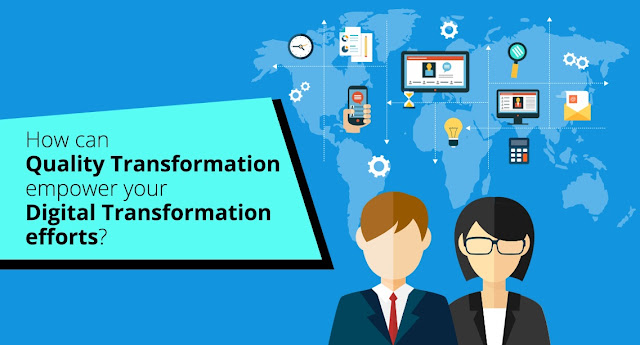Why should the success of DevOps be underpinned on Quality Engineering Services?
 | |
| Quality Engineering Services |
The proliferation of
digital applications owing to various digital transformation initiatives taken
by enterprises has necessitated the adoption of intelligent automated testing.
The changing nature of businesses, market dynamics, and the adoption of new
technology platforms have led to the shrinking of delivery schedules – from
months to weeks and days. Consequently, the testing timelines have caught up
with the change in shifts to the left and right. Companies, to remain agile and
offer the best customer experience, have adopted the development and testing
methodology of DevOps. This entails the testing of code in the initial stages
of the development process and establishing a robust feedback mechanism to act
upon customer issues.
As the traditional mode
of testing takes a backseat with the adoption of Agile and DevOps, the focus is
more towards preventing, detecting, and eliminating glitches. The advent of new
technologies such as IoT, AI, Augmented and Virtual Reality, AMP etc.,
generates humongous amount of data, which if not validated, can result in these
technologies to play truant. Today, the quality of an application is not just
about ensuring the smooth functioning of a software application but rather
offering a differentiated user experience. This is because customers have high
expectations about a product, which if not addressed to everyone’s
satisfaction, can let a software product to go out of reckoning. This brings quality
engineering into sharp focus as routine shift-left testing can suffer from
inadequacies such as lack of scope, inability to predict risk, etc.
Why should Quality
Engineering solutions be preferred?
As new technologies
evolve and are adopted by enterprises, the complexity of software applications
has increased exponentially. This calls for a continuous monitoring of
applications across the SDLC and beyond.
- Digital Quality Engineering can adapt to frequent technology changes and provide a software quality engineer with the necessary wherewithal to ensure the changes lead to the enhancement of quality.
- Helps to align technological priorities with business objectives.
- Helps deliver a shorter time to market, timely updates, and a qualitatively superior user experience.
- Helps in building and deploying applications for omnichannel environments.
- Helps to identify new metrics, be it based on performance or business objectives.
- Delivers enhanced business value to end customers and other stakeholders.
- Offers customer centric innovation, early validation, reduced manual testing efforts, reduced production defects, and overall cumulative savings.
Quality Engineering as a
shift-left and strengthen-right strategy
With technologies like AI
led automation, IoT, social, cloud, and mobile commerce among others being
rolled out by enterprises with alacrity, quality awareness needs to shift-left
and strengthen-right to align with business priorities. The comprehensive QE
environment would encompass data analytics, virtualization, static and dynamic
security testing, intelligent automation, API testing, and performance
engineering. Since QE puts emphasis on comprehensive testing to predict and
detect glitches across the SDLC, it finds itself in alignment with the DevOps
goals.
How does DevOps fit into
the scheme of things?
The DevOps paradigm of
development and testing goes a step further than Agile by involving the
Operations team in delivering quality outcomes. It envisages the creation of a
quality culture where every person in the organization, especially in the
Development and Operations functions, should take the onus of ensuring the
quality of products and services.
The incorporation of
DevOps by organizations may lead to the following outcomes:
- Increasing the level of automation to execute quality validation testing.
- Optimizing the test sets by enhancing the quality of test automation scripts.
- Provisioning of virtual test variables to validate the software application across parameters.
- Integration of digital Quality Engineering with DevOps quality approach.
- Continuous monitoring of quality solutions.
Since DevOps is seen to
be adopted by enterprises to address the rising testing challenges, the two
principles become apparent.
- Develop and deploy automated test solutions swiftly and as per business requirements.
- Drive agility and process excellence across the SDLC by breaking down traditional silos.
Quality engineering
solutions can infuse agility into the SDLC and bridge the gap between
development and deployment of applications. QE services can cover
diverse environments comprising end user device platforms, advanced
technologies, browsers, and databases to validate the features and
functionalities of an application. To deal with the challenges of implementing
DevOps such as delayed deployment, the ‘test early, test often’ approach of quality
engineering through automated testing can prove to be helpful. The
approach validates the quality of an application throughout the SDLC and leverages
a slew of practices – behaviour driven, acceptance test driven and test-driven
development.
QE services enabling
continuous testing in DevOps
The implementation of
DevOps would entail activities such as Continuous Integration (CI), Continuous Testing
(CT), and Continuous Delivery (CD). These can be achieved by framing and
implementing a robust quality engineering strategy comprising the following:
Functional testing: This type of testing focuses on the user interface and ensures all
user requirements function as per expectations. This testing should be executed
throughout the SDLC.
Non-functional testing: This type of testing deals with attributes such as quality,
readiness, performance, throughput, utilization, scalability and security of applications.
Use of cloud: Quality Engineering can perform better in a cloud environment
given the latter’s increased storage capacity, scalability, affordability,
flexibility, and security. Continuous
testing on cloud can be effective as the application can be tested at any
point of time, which unlike in a legacy system, can be cost effective.
Conclusion
Digital Quality
Engineering can ensure continuous integration and testing and offer a holistic
user experience. It leverages the test automation frameworks and tools to
facilitate end to end testing at a faster rate.
Check out this White
Paper to know the significance of Application Performance monitoring for
the aviation industry from Quality Engineering perspective.


Comments
Post a Comment